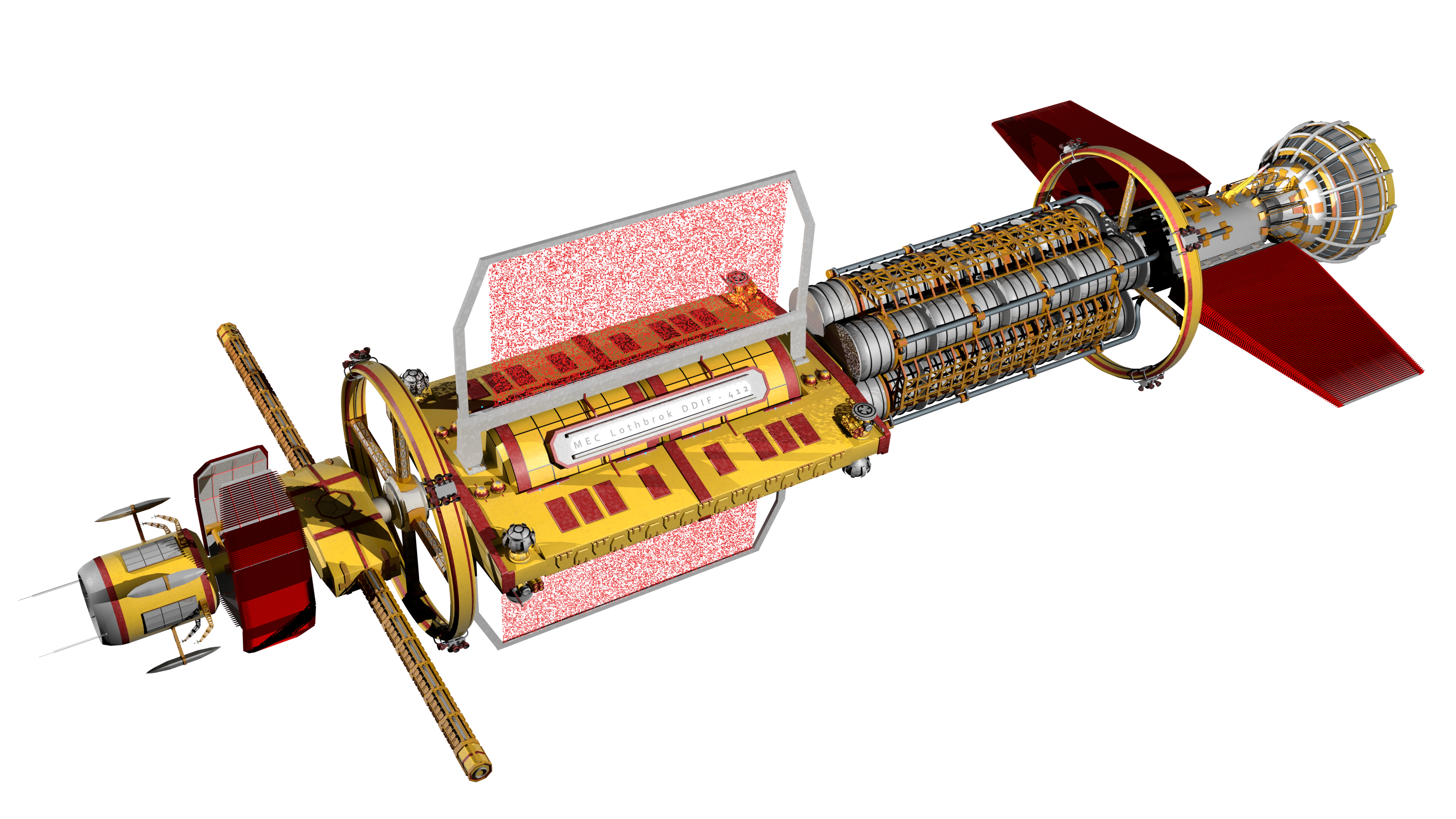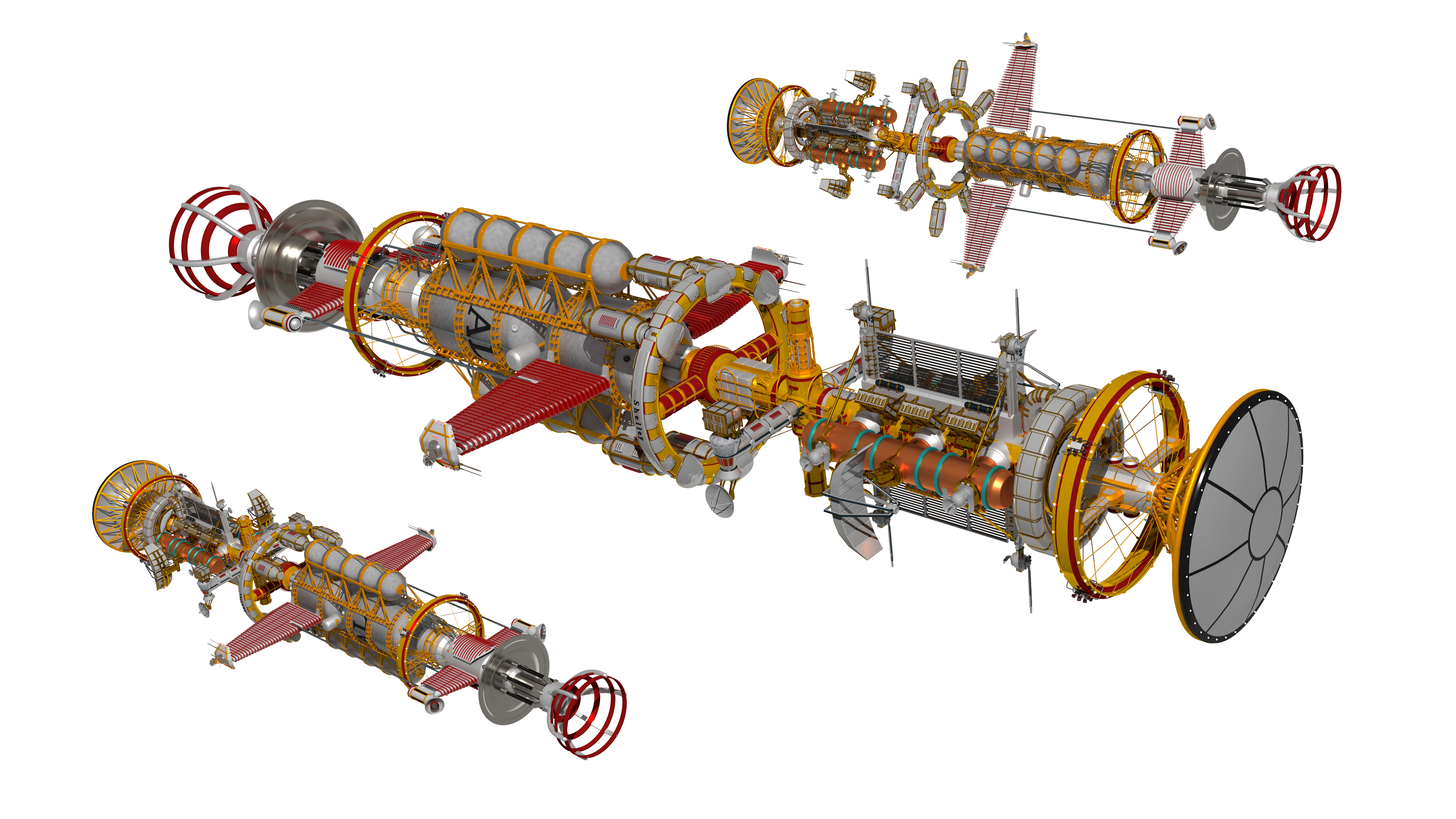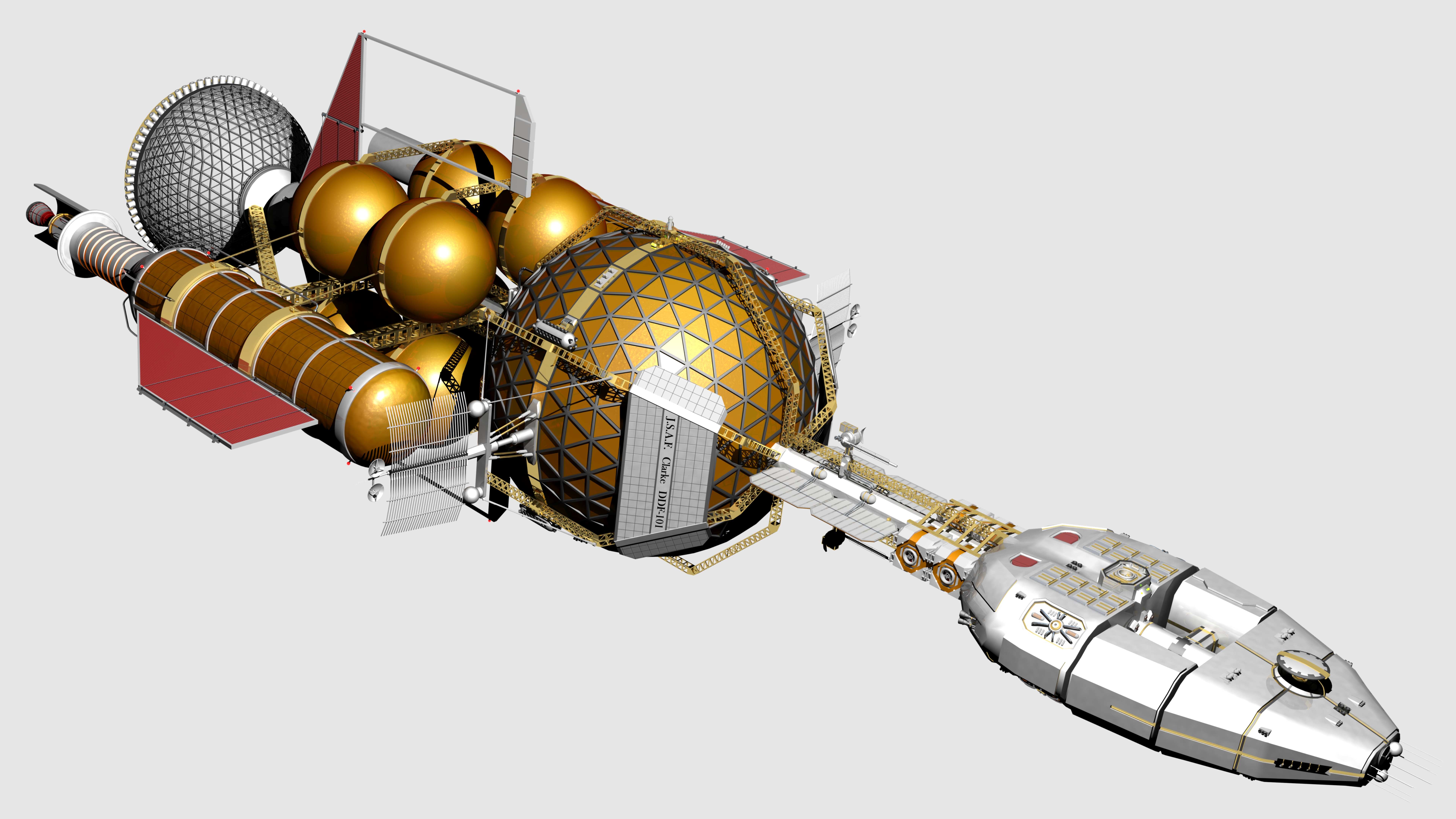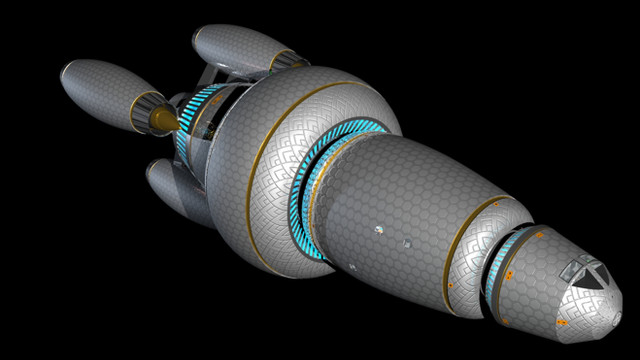HOME | DD
 Do-Mo — Sort of realistic space destroyer 1
Do-Mo — Sort of realistic space destroyer 1

#3d #3ds #big #concept #destroyer #fusion #future #gauss #hunter #mars #model #nuclear #realistic #rocket #space #spaceship #vls #antiship #rocketpunk #reactionwheels
Published: 2016-05-10 10:47:04 +0000 UTC; Views: 6026; Favourites: 83; Downloads: 93
Redirect to original
Description
Martian Expeditionary Coprs interplanetary fusion destroyer Lothbrok.Length: 253m
Height: 81m
Width: 102m
Dry mass: 18 000 tons
Full load: 22 000 tons
Complement: 120
Armaments:
4x 50mm Gauss Gun
16x 4m Point defense missiles
34x 11m Long range missiles
Main engine: Inertial confinement fusion
Thrust: 20 MN
Fuel: He-3 - D
Fuel supply: 1300 tons
Mass flow: 2,2 Kg/s
Acceleration while fully loaded: 0,9 M/s
Delta-v: 550 km/s
Thrusters
Hydrogen - Oxygen chemical rockets
-augmented by reaction wheels
Lothbrok class destroyer, a third generation warship, once a workhorse of Martian Expeditionary Corps, now a somewhat aging design, slowly being outclassed by newer designs, but still a potent warship.
Originally it was a cruiser sized anti ship hunter, which saw some service in the Martian-Jovian conflict, where it heavily outclassed the Jovian Clarke class destroyers.
Only with a much later introduction of Wells class destroyers did the Jovians truly achieve an equal footing in this ship size.
The design is a dedicated warship, focused on offensive, while somewhat lacking in defenses, still it excels in fleet engagements where other ships provide majority of point and area defense.
Somewhat unusually among other capital ships, it carries no support vessels, large cargo holds, or even externally carried cargo boxes.
However it is built to be able to perform precise maneuvers, and with its extended docking port, easily dock with other ships, whether it be to receive additional supplies from allies, or take them by force from enemies.
One noticeable features are support struts built around the fuel tanks, which can actually mount up to 16 large cargo boxes, to either turn a single destroyer into a tender for the remainder of its strike group, or make it serve as an emergency transport ship. This configuration severely limits ships maneuverability, as it cuts maximum speed and acceleration by almost 50%, so it makes it nearly unusable in combat.
Crew count is quite large for its size with the purpose of adding redundancy(in case of lost lives), and rarely, to provide boarding potential.
Some minor sensation of gravity is provided with 2 contra rotating cylinders in which the crew is housed, but as it is a dedicated warship, crew comfort is a low priority.
Another oddity is that it carries lifeboats for only half of its crew, which is especially a surprise among Martian designs, as they tend to place a high value on the lives of their citizens, however this measure is placed to simplify the design and decrease weight overall, reasoning that if the crew had to use lifeboats, large portion of the crew would be dead already.
Its major priority is its offensive capability which, at 34 capital missile silos, is very potent for this ship size.
While defenses are somewhat neglected it's still not a frail ship, mostly unarmored, but with reinforced structure at all the would-be weak spots, which enables it to utilize fully its maneuvering abilities.
Maneuverability being its main defense is, with chemical rocket thrusters, additionally augmented with large reaction wheels positioned in two rings placed at the front and back.
As a last line of defense it will use its 4 point defense turrets, each armed with 4 anti-missile launchers, and a 50mm rapid fire EM cannon.
Heat is managed with 2 sets of heavy duty passive radiators, one set placed near the main engine, and the other between main processing units and crew sections. When needed it can also activate its set of liquid droplet radiators.
To this day, it remains the most numerable among Martian warships, largely because of its modular construction, which simplified rapid construction of its sections, and later on, it enabled easy refits and maintenance, giving it a long service life.
While it's not the apex predator of Solar system it once was, it still represents an important part of Martian military might.
Related content
Comments: 14

Thank you!
I must admit, I'm surprised at how many people like this one, especially since I was so unsure about the colors!
👍: 0 ⏩: 1

The colors are fine, no worries on them.
I find that people like the "solar" colors of orange, red, yellow, and combinations when done in metallics.
On my General Atomics spacecraft I used a lot of orange and red, intermixed with a "rust" color and shades of gray. I was worried about the colors of that ship but people seem to like it, so I am not surprised that your ship here is liked by so many people. It came out fantastic with this color scheme.
👍: 1 ⏩: 1

You're probably right about the colors, even though I personally prefer a simpler color scheme, something white with few pronounced details, but that's partially because I'm really bad at combining colors. ...in fact I love making models, but hate painting them
Another part to it is that I THINK white colored ships would be a bit more realistic, since white color would attract less heat.
Still I didn't want all my ships to look so similar so this, fortunately successful, experiment happened. A good foundation for other ships of this "faction".
I must say I like how the rings give some similarity to our ships!
Funny thing is that an upgraded version of this ship that I imagined(but have yet to move a first vertex for it) would use Orion style nuclear pulse propulsion, but among other changes would lose the fancy rings
👍: 0 ⏩: 2

I find those colors attract people.
White colored ships for exploration, and many other non-military applications definitely makes sense, but I find that the Chris Foss and Peter Elson style of multi-colored (done tastefully) ships have a more militaristic look to them.
So I do use white for my civilian ships like my space shuttle , but use a wide variety of colored ships for my science fiction world's military craft.
Colors are a great medium for expressing different factions of ships.
Freeman Dyson's "Pusher Plate" ships make for a great study-piece to add to science fiction ships. Some of their proposed "designs" for super space battleships powered by their pusher plate are just hilarious. Especially when you realize they were just stroking the ego of the USAF to get funding for their projects.
The rings on our ships are because all great minds think alike. 
On mine, it is simply to create an artificial--Gravito-Electric field/"fake" planetary electromagnetic field--and deflect particles to allow the ship to travel as fast--in Delta-V--as the human crew can handle with the g-compensation of those rings. The rings on my ship use Hopfions to generate the field. I took the idea from this article.
hopfion.com/elmag.html
👍: 0 ⏩: 0

The droplet radiator is pointed in the wrong direction unless it's only used when not under acceleration... but then that means it's spraying the coolant...
👍: 0 ⏩: 1

I always assumed droplets would not be really practical while under acceleration, especially not on a spaceship with a pulse engine. Maybe something that's triangle or even pyramid shape would be much more useful while accelerating (rotated by 90 degrees obviously)? But wouldn't that decrease the useful radiator area?
Still that was just an assumption on my part, so I prefer to make something like this which would be active between accelerations, but seems like a simpler design.
👍: 0 ⏩: 1

The main question is the direction the droplets are traveling. Hopefully you have them moving outward, not inward. The reason being is that most ships fire their maneuver thrusters in an automatic station keeping mode and when that happens you'll lose a load of the droplets as they miss the catcher. If they are falling inward... You'd end up spraying the hull of the ship with red hot droplets.
👍: 0 ⏩: 2

The droplets could be traveling along the spine of the hull and not reduce the surface area of the radiator while being able to be used both at acceleration and deceleration.
If the ship accelerates, the drops leave at the prow, travel along the spine radiating heat and (most) would be caught at the stern end. Deceleration has the droplets leaving at the stern and traveling along the spine to be caught at the prow side.
If the ship has to move "sideways" a part of the droplets will be lost but they won't be hitting the hull nor create a large spray around the ship.
...but then, a large sheet of heat absorbing/radiating droplets could be useful to mask the true size of the ship on long range IR scanners as well as maybe dispersing some incoming laser fire.
If there were lasers, going by the list of armaments this setting relies on more conventional weaponry.
👍: 0 ⏩: 1

Both of you have given me comments that I hope for whenever I post something, while praise is always nice, constructive critique is even better.
It's a simple thing, something that I hadn't even consider much while making the model, yet an useful detail.
It will be a minor change overall, but I will rotate droplets direction, I was going to use this ship in a scene which I (hopefully) will post real soon, so the change should be visible there.
In all honesty, I know nothing about masking IR signatures, or how useful it could be. I tend to stick with the classic "there is no stealth in space", while just assuming actual warships would use every trick they can to fool their enemies, be it with ECM, hacking, general radio clutter, dumping chaff, scraps or even heated coolant.
And yeah I prefer more conventional looking weaponry(with the addition of casaba howitzers)...funny how it seems that present-day warships(and even warplanes! ) are getting lasers before my modes!
👍: 0 ⏩: 1

You're right, there is no stealth in space unless you add some Unobtanium, encased in generous amounts of Handwavium and held together by technobabble.
Every ship leaves traces and with some time and proper resolution sensors will pick up these traces. Atomicrocket ( projectrho.com )has a very nice article about detection in space and why our technology just doesn't allow us to hide.
Space is too open, cool and generally empty too hide your waste heat and every working piece of equipment (which you need a lot of) generates waste heat.
So, the question is: are your enemies (or their sensors) good enough to notice the heat signature (very likely) and figure out what kind of ship is giving off about that much heat?
If you loose some heated coolant and this creates a warm fog around your ship, at least long range scanners won't be able to identify your class of vessel before you come closer. That has to do with sensor resolution, they are either good at picking up details but lousy at range or good at picking up faint traces far away while providing very little detail.
Nice to hear you're working on a scene, I'll be waiting to see what it is
👍: 0 ⏩: 1

Yeah, about sensor resolution, I may have dug myself into a hole on that part
I'm always a bit unsure about how to finish the "head" of the ship, without it looking like a standard SF penis shaped flying boat, so some time ago it became a habit to make the head be a giant radar dish. As seen here and here . A potential problem with having a 25 meter diameter dish in space is that it could probably keep track of tens of thousands of object at the same time, and see more of space than all our current telescopes combined. It could be said that something like that is necessary to avoid any harmful space debris, guide tens of missiles(or hundreds if multiple warheads are used on individual missiles). Or it could be something that is emitting massive jamming signals to deflect enemy missiles. Or in some probably stretched out scenario, it could be some magnetic or electrostatic field generator acting somewhat like Star trek deflector dish for space debris. In reality it would probably end up being degraded like a Whipple shield with all the space dust hitting it
Always working on something, after all, so far all the spaceships in my gallery are part of a combined universe, so they can all hang out sometime
👍: 0 ⏩: 0

Well a pragmatic answer would be that it doesn't really matter which way I have them facing, since changing their direction is just a declaration from my part
But yeah I did imagine them moving outward for the reason you stated, coolant should be preserved for further use, but if some is lost, logically you'd want it to be away form the main hull.
👍: 0 ⏩: 0




























